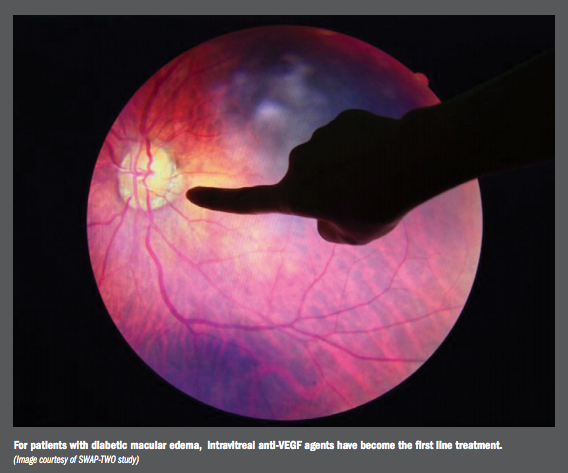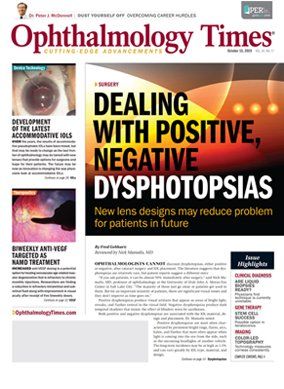Publication
Article
Digital Edition
The ABCs of VEGF treatment for diabetic macular edema
Author(s):

For patients with diabetic macular edema (DME), intravitreal anti-vascular endothelial growth factor (VEGF) agents have become the first-line treatment. There are currently only two VEGF inhibitors approved for use in the United States for the treatment of DME: aflibercept (Eylea, Regeneron) and ranibizumab (Lucentis, Genentech).
Bevacizumab (Avastin, Genentech) is often used off-label, and pegaptanib (Macugen, Bausch + Lomb) has declined in use since the introduction of both aflibercept and ranibizumab. Numerous clinical trials have shown both visual acuity (VA) and anatomic outcomes can be improved with the use of the anti-VEGFs, yet reports of persistent DME remain despite continuous anti-VEGF therapy. Extension studies of RESTORE, RISE and RIDE all show a decline in VA when patients were transitioned to a more flexible treatment after being on a fixed dosing regimen.1,2 Related: Managing uveitic macular edema
The SWAP-TWO study3 was a prospective, interventional, single-arm study (Cole Eye Institute) that enrolled 20 eyes of 20 patients between December 2015 and August 2017 to evaluate the effects of switching patients with DME to aflibercept after being previously treated with other anti-VEGF agents; the study also placed these patients on a fixed dosing regimen. This initial six-month interim analysis suggests switching agents can substantially improve anatomic outcomes while maintaining vision gains.
In SWAP-TWO,3 eligible participants were aged ≥ 18 years with foveal-involving retinal edema secondary to diabetic retinopathy (DR) based on investigator review of clinical exam and spectral-domain optical coherence tomography (SD-OCT) with central subfield thickness of 325 μm, best corrected visual acuity (BCVA) of 20/25 to 20/400 in the study eye, and history of previous treatment with bevacizumab or ranibizumab with at least four previous injections in the last six months.
Related: Sustained DRSS improvement with aflibercept
Patients were excluded if they had a history of aflibercept use, or if they had used systemic anti-VEGF therapy in the three months prior to enrollment. The average age at screening was 63.7 years, 13 enrolled subjects were female (65%), and the average number of prior injections was 4.25 during the six months prior to study enrollment. Nine of the eyes were considered to have moderate DR severity, and the mean central subfield thickness was 419.7 μm in the study eye.
The majority of patients had been treated with bevacizumab (95%). Patients were administered 2 mg (0.05 mL) of intravitreal aflibercept administered monthly until there was no evidence of fluid as determined by OCT. (For this study, “no evidence of fluid” was considered to include lack of subretinal fluid, a central subfield thickness of < 320 μm, or a foveal cystoid macular edema with focal depression present or with fovea flat.)
Related: Deep learning predicts OCT measures of diabetic macular thickening
Patients were administered fixed aflibercept once every two months; “failure” was defined as a loss of 15 or more ETDRS letters from the best previous measurements and an increase of 75 μm compared to the previous visit measurement. The investigators allowed an additional treatment with aflibercept for those patients.
The primary outcome of the study was defined as the mean absolute change from baseline central foveal thickness at month 12 with pre-planned interim analysis as measured by SD-OCT (defined as the average thickness within the central 1 mm subfield) at month 6.
Secondary outcomes included the efficacy of treatment outcomes by improvements in ETDRS BCVA from baseline, perfusion changes in OCTA before and after therapy, as well as safety and tolerability of aflibercept therapy by monitoring adverse events.
Related: Laser therapy maintains position as key DME treatment Study outcomes
Patients received an average of 5.25 injections over an average of 5.3 visits. (Fellow eye injections averaged 2.15 in 65% of patients.) At month 6, 11 patients (55%) still needed monthly treatment, while nine patients were able to move to q2 month dosing after an average of 3.3 injections with aflibercept.
Central subfield thickness improved from 419.7 ± 92.0 (328–585) μm at baseline to 303.8 ± 73.1 (198–485) μm at month six (27.63% reduction). Each subsequent visit had statistically significant improvement in central subfield thickness from baseline (p < 0.001 for all time-point comparisons).
Throughout the study period, no change in DR severity was observed. Two patients had epiretinal membrane at baseline and no visual change was seen at 6 months. BCVA increased minimally between the baseline visit and six months, [70.0 ± 7.2 (60–81) to 71.5 ± 8.9 (54–83) letters], but this change was not statistically significant (p = 0.38).
Related: Several cyst characteristics linked to ischemia in DME
At baseline, 65% (n = 13) patients were 20/40 or better, 35% (n = 7) patients were 20/50 or worse, and no patients were 20/200 or worse. By the end of month six, 12 patients (60%) were 20/40 or better, eight patients (40%) were 20/50 or worse, and no patients were 20/200 or worse.
Conclusions
SWAP-TWO found “significant anatomical improvements” could be achieved when switching patients to aflibercept from other anti-VEGFS. The study confirms findings from other retrospective studies, the authors noted, where significant anatomic improvement without BCVA gains have been reported.
“Overall, this study begins to offer useful clinical insights into switching anti-VEGF medications followed by extended treatment intervals of aflibercept,” the authors wrote.3 “The 12-month results of this study will be helpful in determining whether vision does indeed improve with continued treatment, and if fixed-dosing at a longer interval once macular fluid is resolved can sustain these positive effects.”
Read more by Michelle Dalton
References:
1. Boyer DS, Nguyen QD, Brown DM, Basu K, Ehrlich JS: Outcomes with As-Needed Ranibizumab after Initial Monthly Therapy: Long-Term Outcomes of the Phase III RIDE and RISE Trials. Ophthalmology. 2015, 122(12):2504- 2513.e2501.
2. Schmidt-Erfurth U, Lang GE, Holz FG, Schlingemann RO, Lanzetta P, Massin P, Gerstner O, Bouazza AS, Shen H, Osborne A et al: Three-year outcomes of individualized ranibizumab treatment in patients with diabetic macular edema: the RESTORE extension study. Ophthalmology. 2014, 121(5):1045-1053.
3. Babiuch AS, Conti TF, Conti FF, Silva FQ, Rachitskaya A, Yuan A, Singh RP: Diabetic macular edema treated with intravitreal aflibercept injection after treatment with other anti-VEGF agents (SWAP-TWO study): 6-month interim analysis. Int J Retina Vitreous. 2019, 5:17.
Newsletter
Don’t miss out—get Ophthalmology Times updates on the latest clinical advancements and expert interviews, straight to your inbox.






